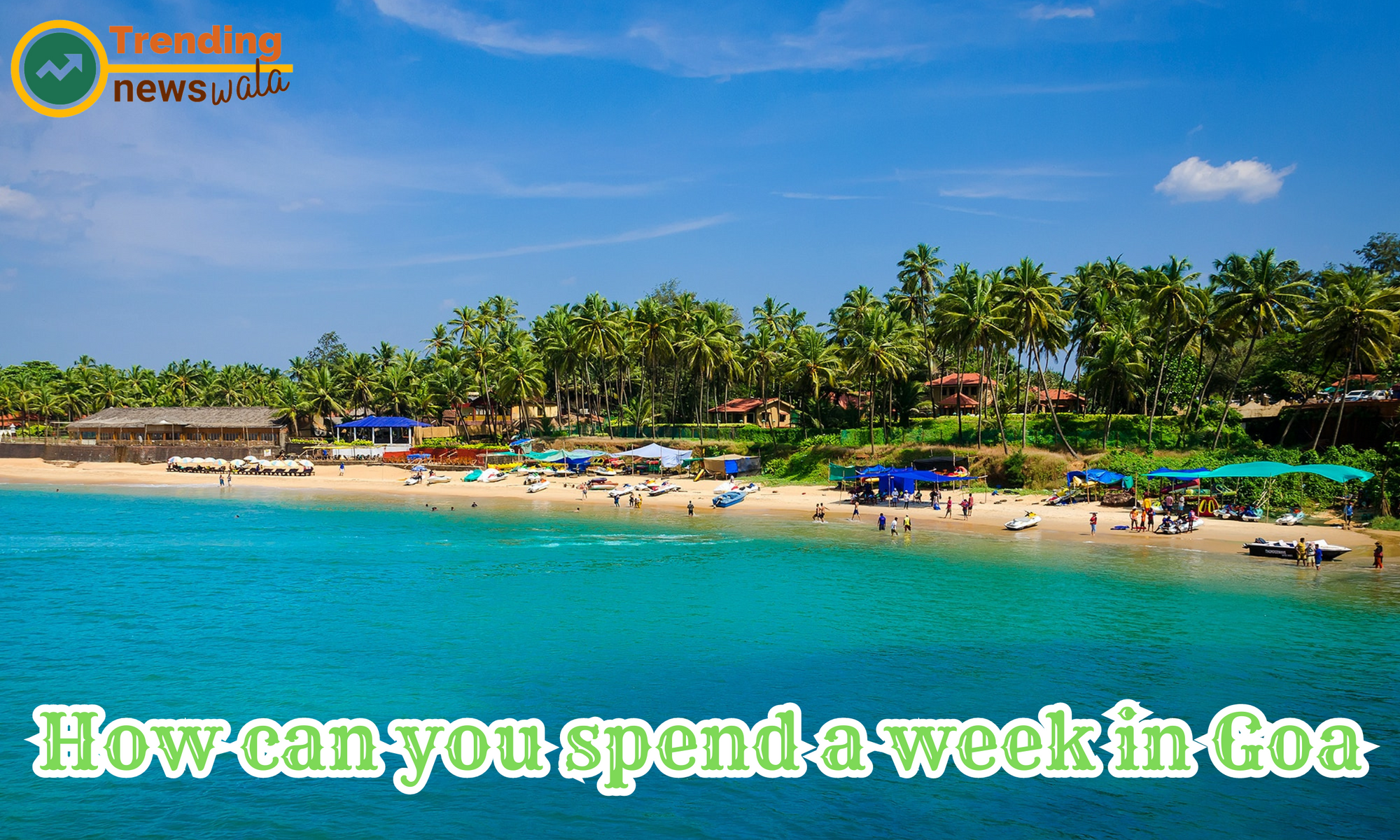How can you spend a week in Goa?
Nestled along the sun-kissed shores of the Arabian Sea, Goa stands as a beacon for those seeking an idyllic blend of beaches, culture, and vibrant energy. With its sandy shores, lush landscapes, and vibrant nightlife, Spending a week in Goa promises a rejuvenating and unforgettable experience. In this guide, we'll explore how you can make the most of your seven days in this coastal paradise.
Day 1:
- Morning: Arrive in Goa and settle into your accommodation, whether it's a beachside shack, a cozy guesthouse, or a luxurious resort. Begin your day with a stroll along the iconic Calangute Beach, immersing yourself in the lively atmosphere.
- Afternoon: Head to Baga Beach for a delicious seafood lunch at one of the beachside shacks. Try local Goan delicacies like fish curry rice or prawn curry.
- Evening: Explore the vibrant markets of Anjuna or Mapusa for some souvenir shopping. As the sun sets, unwind with a beachside dinner and live music at one of the many beach clubs.
Day 2:
- Morning: Dive into an adventure-packed morning with water sports at Vagator Beach. Choose from jet skiing, parasailing, or banana boat rides for an adrenaline rush.
- Afternoon: Visit the iconic Chapora Fort for panoramic views of the coastline. Enjoy a relaxing lunch at one of the cliffside cafes.
- Evening: Spend the evening at the lively Anjuna Beach. Embrace the bohemian vibes with its flea markets, beachside bars, and a vibrant nightlife scene.
Day 3:
- Morning: Visit the Basilica of Bom Jesus, a UNESCO World Heritage site, to marvel at its baroque architecture and the preserved body of St. Francis Xavier.
- Afternoon: Explore the Sé Cathedral and St. Cajetan Church, soaking in the rich history and religious significance.
- Evening: Take a leisurely stroll through the Fontainhas Latin Quarter, known for its colorful Portuguese-style houses. Enjoy a traditional Goan dinner at a local eatery.
Day 4:
- Morning: Visit the Archaeological Museum to delve deeper into Goa's history. Alternatively, spend the morning at the Museum of Christian Art.
- Afternoon: Head to the vibrant Shanta Durga Temple and Mangeshi Temple to experience Goa's Hindu culture.
- Evening: Conclude your cultural immersion with a river cruise on the Mandovi River, complete with traditional Goan music and dance performances.
Day 5:
- Morning: Travel to Palolem Beach, known for its crescent-shaped coastline and relaxed atmosphere. Enjoy a beachside breakfast and consider a morning yoga session.
- Afternoon: Explore Butterfly Beach or take a boat trip to the peaceful Honeymoon Beach. Enjoy a seafood lunch with your toes in the sand.
- Evening: Immerse yourself in the vibrant nightlife of Palolem, with beachside cafes and bars offering live music.
Day 6:
- Morning: Discover the tranquility of Agonda Beach. Relax, sunbathe, or take a long walk along the pristine shore.
- Afternoon: Head to Cabo de Rama Fort for panoramic views of the Arabian Sea. Enjoy a picnic with snacks from local vendors.
- Evening: Savor a sunset dinner at a beachside restaurant in Agonda.
Day 7:
- Morning: Spend your last day in South Goa at Colva Beach. Indulge in water sports or simply relax on the beach.
- Afternoon: Explore the vibrant Colva market for souvenirs and local crafts.
- Evening: Conclude your week-long adventure with a beachside dinner, reflecting on the memories created during your time in this coastal haven.
A week in Goa unfolds as a journey through diverse landscapes, from the vibrant energy of North Goa to the historical charm of Old Goa and the serene beaches of the south. This itinerary provides a balance between adventure, relaxation, and cultural exploration, ensuring that every moment is a celebration of Goa's unique spirit. Whether you're seeking the thrill of water sports, the tranquility of a sunset, or the rich history embedded in the region, Goa welcomes you with open arms for an unforgettable week-long escapade
Trending News Offer for New Thrilling Adventure
Everest Base Camp Trek

Certainly! The Everest Base Camp (EBC) Trek is one of the most iconic and popular trekking routes globally, attracting adventure enthusiasts and nature lovers from around the world. The trek takes you to the foothills of the world's highest peak, Mount Everest (8,848 meters or 29,029 feet), offering breathtaking landscapes, unique Sherpa culture, and unparalleled views of the Himalayas. Here are more details about the Everest Base Camp Trek:
Duration: The typical duration of the Everest Base Camp Trek is around 12 to 14 days, depending on the chosen itinerary and acclimatization needs. This includes both the trek to the base camp and the return journey.
Starting Point: The trek usually begins with a scenic flight from Kathmandu, the capital of Nepal, to Lukla. Lukla serves as the gateway to the Khumbu region and the starting point of the trek.
Itinerary: The trek follows a well-established route, passing through various Sherpa villages, monasteries, and stunning landscapes. Common stops include Phakding, Namche Bazaar, Tengboche, Dingboche, Lobuche, and Gorak Shep.
Altitude and Acclimatization: One of the crucial aspects of the Everest Base Camp Trek is acclimatization. Altitude sickness is a risk at higher elevations, so the itinerary is designed to allow trekkers to acclimatize gradually. Acclimatization days are often included in Namche Bazaar and Dingboche.
Highlights:
- Namche Bazaar: A bustling market town and the commercial hub of the Khumbu region.
- Tengboche: Home to the famous Tengboche Monastery with stunning views of Ama Dablam.
- Dingboche: A picturesque village surrounded by high peaks, offering breathtaking views.
- Gorak Shep: The last settlement before Everest Base Camp, from where trekkers embark on the final push to the base camp.
Everest Base Camp:
- The trek culminates at Everest Base Camp, situated at an altitude of around 5,364 meters (17,598 feet). Trekkers get a close-up view of Mount Everest and the surrounding peaks. The base camp is the starting point for climbers attempting to summit Everest.
Kala Patthar:
- Kala Patthar, meaning "Black Rock," is a popular vantage point near Everest Base Camp. Trekkers ascend Kala Patthar for stunning panoramic views of Mount Everest, Nuptse, and surrounding peaks. Sunrise or sunset views from Kala Patthar are particularly breathtaking.
Accommodation: Accommodation along the trekking route varies from teahouses to basic lodges. Teahouses provide a warm and communal atmosphere, allowing trekkers to connect with fellow travelers and experience Sherpa hospitality.
Best Time to Trek: The primary trekking seasons are in the spring (March to May) and autumn (September to November). During these times, the weather is relatively stable, with clear skies and moderate temperatures.
Permits: Trekkers are required to obtain a Sagarmatha National Park entry permit and a TIMS (Trekkers' Information Management System) card before starting the Everest Base Camp Trek.
Physical Fitness: The trek is considered challenging, and trekkers should be in good physical condition. Regular cardiovascular exercise and strength training are recommended to prepare for the altitude and the trek's demanding terrain.
The Everest Base Camp Trek offers a life-changing experience, allowing trekkers to immerse themselves in the Himalayan landscape, witness the Sherpa way of life, and stand in awe of the world's highest peaks. As conditions and logistics may change, it's essential to consult with experienced trekking agencies and stay updated on the latest information before embarking on this adventure
It is incredible to believe if you have a two-week holiday from your office then you can visit our special Everest Tracking with Offferable Price. Everest base camp Trek is one of the greatest mountain trackings on earth. On this eleven-day trek, we witness some of the most breathtaking scenery, visiting some of the highest villages in the world, and admiring the sunrise over the Himalayan snow-capped peaks and Khumbu Glacier. From the peak of Kala Patthar, we gaze up at the mighty Everest summit. Standing on the roof of the world is an incredible shared moment that will last a lifetime.
Annapurna Base Camp Trek

Certainly! The Annapurna Base Camp (ABC) Trek is another popular and captivating trekking destination in the Himalayas, drawing trekkers with its stunning landscapes, diverse flora and fauna, and magnificent mountain views. Here are more details about the Annapurna Base Camp Trek:
Duration: The Annapurna Base Camp Trek typically takes around 7 to 12 days, depending on the specific route chosen, acclimatization needs, and the starting point.
Starting Point: The trek often begins in Nayapul, which is easily accessible from Pokhara. Nayapul is the gateway to the Annapurna region.
Itinerary: The trek follows a well-established route through picturesque villages, terraced fields, and lush forests. Common stops include Tikhedhunga, Ghorepani, Poon Hill, Tadapani, Chhomrong, Bamboo, Deurali, and finally, Annapurna Base Camp.
Altitude and Acclimatization: Acclimatization is essential, and the itinerary includes gradual ascents with rest days to minimize the risk of altitude sickness. Common acclimatization points include Ghorepani and Tadapani.
Highlights:
- Poon Hill: A popular vantage point for panoramic views of the Annapurna and Dhaulagiri mountain ranges, especially during sunrise.
- Hot Springs at Jhinu Danda: A relaxing stop with natural hot springs to soothe tired muscles.
- Machapuchare Base Camp (MBC): Offers stunning views of Machapuchare, also known as the "Fishtail" mountain.
- Annapurna Base Camp: The final destination with breathtaking views of Annapurna I, Annapurna South, Hiunchuli, and other peaks.
Annapurna Sanctuary: Annapurna Base Camp is located in a glacial basin known as the Annapurna Sanctuary. The sanctuary is surrounded by towering peaks, creating a natural amphitheater.
Accommodation: Accommodations along the route range from teahouses to lodges. The teahouses provide basic amenities, meals, and a chance to interact with local communities.
Best Time to Trek: The best seasons for the Annapurna Base Camp Trek are spring (March to May) and autumn (September to November). During these times, the weather is stable, and the skies are generally clear.
Permits: Trekkers need to obtain an Annapurna Conservation Area Permit (ACAP) and a Trekkers' Information Management System (TIMS) card before starting the trek.
Physical Fitness: The Annapurna Base Camp Trek is considered moderately challenging. Trekkers should be in good physical condition and undertake some pre-trek training to ensure an enjoyable experience.
Cultural Exploration: The trek offers opportunities to experience the culture of the local Gurung and Magar communities. Villages along the route provide insights into traditional mountain life.
Annapurna Conservation Area: The trek takes place within the Annapurna Conservation Area, a protected region known for its diverse ecosystems, including rhododendron forests, bamboo groves, and alpine meadows.
Views of Annapurna Peaks: The trek provides spectacular views of Annapurna I (8,091 meters), Annapurna South (7,219 meters), Machapuchare (6,993 meters), Hiunchuli (6,441 meters), and other surrounding peaks.
The Annapurna Base Camp Trek is a captivating journey that combines natural beauty, cultural experiences, and the thrill of reaching a high-altitude destination. Trekkers can witness the dramatic landscapes of the Annapurna region while enjoying the warmth and hospitality of the local communities along the way. As with any trek, it's essential to plan adequately, consult experienced trekking agencies, and stay informed about current trail conditions and logistics
If you are looking for a 1-week trek in Nepal, that will lead you high into the Himalayan mountains, look no further than Annapurna Base Camp Trek. Sitting at an altitude of 4130m, it is by no means an easy feat. But, if you are reasonably fit (in both body & mind), you should have no problems completing the Annapurna Base Camp trek in 7 days.
Manaslu Circuit Trek

Certainly! The Manaslu Circuit Trek is a challenging and remote trekking adventure that takes you around the eighth highest mountain in the world, Mount Manaslu (8,163 meters or 26,781 feet). This trek offers a unique blend of natural beauty, cultural diversity, and a sense of wilderness as you traverse through pristine landscapes in the Manaslu Conservation Area. Here are more details about the Manaslu Circuit Trek:
Duration:
The Manaslu Circuit Trek typically takes around 14 to 18 days, depending on the specific route chosen, acclimatization needs, and the starting and ending points.
Starting Point: The trek often begins in Sotikhola, accessible by a long drive from Kathmandu. The road journey passes through scenic landscapes and rural villages.
Itinerary: The trek follows a circular route around Mount Manaslu, passing through diverse landscapes, traditional villages, and challenging mountain terrain. Common stops include Machhikhola, Jagat, Deng, Namrung, Lho, Sama Gaon, Samdo, Dharamsala (Larkya Phedi), and Bimthang.
Altitude and Acclimatization: Acclimatization is crucial due to the high altitudes reached during the trek. The itinerary includes rest days for acclimatization in Sama Gaon and Samdo.
Highlights:
- Manaslu Base Camp: A side trip to Manaslu Base Camp offers stunning views of the towering Manaslu and surrounding peaks.
- Larkya La Pass: The trek crosses the challenging Larkya La Pass (5,160 meters or 16,929 feet), providing panoramic views of the Manaslu range.
- Cultural Encounters: The trek allows interaction with diverse ethnic communities, including Gurungs, Sherpas, and Tibetans, providing insight into their unique cultures and traditions.
Accommodation: Accommodations along the route range from basic teahouses to lodges. The teahouses provide essential amenities, meals, and a chance to connect with local communities.
Best Time to Trek: The ideal trekking seasons for the Manaslu Circuit are spring (March to May) and autumn (September to November). During these periods, the weather is generally stable, and the views are clear.
Permits: Trekkers need to obtain a restricted area permit for the Manaslu Conservation Area, a Manaslu Conservation Area Permit (MCAP), and an Annapurna Conservation Area Permit (ACAP) for parts of the trail.
Physical Fitness: The Manaslu Circuit Trek is considered strenuous and requires a good level of physical fitness. Trekkers should be prepared for long and challenging days of walking, including high-altitude passes.
Remote and Untouched Nature: The trek offers a sense of seclusion and wilderness, with fewer trekkers compared to some of the more popular trekking routes in Nepal. The landscapes remain relatively untouched and pristine.
Cultural Immersion: The trek provides opportunities to immerse yourself in the rich cultural traditions of the region, from ancient monasteries to traditional village life.
Manaslu Conservation Area: The trek takes place within the Manaslu Conservation Area, renowned for its diverse flora and fauna, including the elusive snow leopard.
The Manaslu Circuit Trek is an adventure for those seeking a more off-the-beaten-path experience in the Himalayas. Trekkers are rewarded with breathtaking mountain vistas, cultural encounters, and the satisfaction of completing a challenging and rewarding journey around the iconic Mount Manaslu. As always, thorough preparation, experienced guides, and up-to-date information are essential for a successful trek in this remote region.
Manaslu is the most popular non-tourist area for trekking in Nepal. You'll see beautiful scenery and learn about Tibetan culture in the Gorkha Manasalu region of mid-western Nepal. Nepal is gifted with a wide variety of land topography. Some of the trekking routes are challenging, while some hikes are easy. Among the most challenging trekking routes in Nepal, Manaslu is one that offers majestic views. The new trial of the Manaslu circuit has left most visitors awestruck with its serene beauty and pure wilderness. Manaslu Circuit Trek has formed a natural barrier between Nepal and the Tibetan plateau. This circuit offers you an exclusive opportunity to circumference the world's eighth highest mountain, Manaslu, and witness panoramic, incomparable vistas of the world's tallest peaks.



